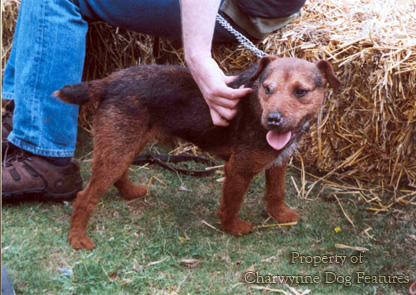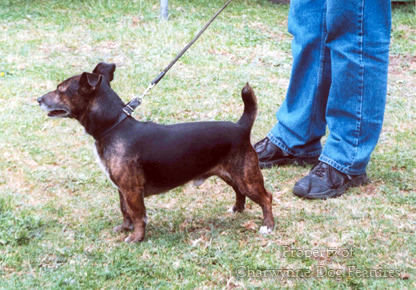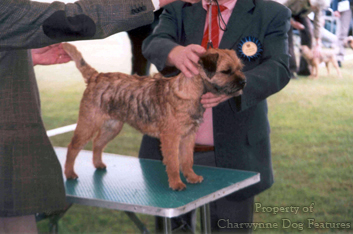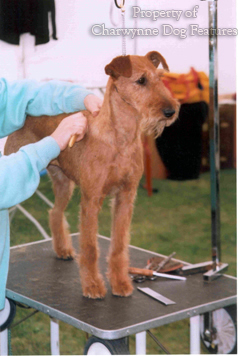755 BREEDING EM RIGHT.doc
BREEDING ‘EM RIGHT: Creating Sound Terriers
by David Hancock
 Going from a hunt terrier show one week then to a Kennel Club championship show a week or so later gave me a stark reminder of the gulf between the two in terms of terrier design. I went to the KC-approved show on ‘terrier’ day; the KC puts the terrier group in their sporting division and commendably stresses that all their exhibits must be fit for function. Their breed standards for the sporting terrier breeds aim to highlight the role-dictated anatomy such dogs should feature. For the KC, the Dandie Dinmont has to be ‘game and workmanlike’; the wire-haired Fox Terrier should ‘stand like a short-backed hunter’; the smooth version should have ‘well laid back shoulders’; the Sealyham should have a ‘punishing square jaw, powerful and long’. I am glad to see that the Parson Russell Terrier’s word picture has been changed to omit the words ‘and run with hounds’ from the wording asking for ‘the conformation to go to ground’.
Going from a hunt terrier show one week then to a Kennel Club championship show a week or so later gave me a stark reminder of the gulf between the two in terms of terrier design. I went to the KC-approved show on ‘terrier’ day; the KC puts the terrier group in their sporting division and commendably stresses that all their exhibits must be fit for function. Their breed standards for the sporting terrier breeds aim to highlight the role-dictated anatomy such dogs should feature. For the KC, the Dandie Dinmont has to be ‘game and workmanlike’; the wire-haired Fox Terrier should ‘stand like a short-backed hunter’; the smooth version should have ‘well laid back shoulders’; the Sealyham should have a ‘punishing square jaw, powerful and long’. I am glad to see that the Parson Russell Terrier’s word picture has been changed to omit the words ‘and run with hounds’ from the wording asking for ‘the conformation to go to ground’.
I find it hard to link a game and workmanlike terrier with one prized mainly for its topknot. I cannot understand why any terrierman would want his dog to be built like a short-backed hunter; a terrier is a canine miner not a steeplechaser. Wild mammals that succeed underground have long backs. Ba dgers, formidable adversaries for any dog, do not need square, long powerful jaws to punish. The physical criteria to produce a ‘running terrier’ are at odds with those needed by a digging dog. Why do these old canards survive?
dgers, formidable adversaries for any dog, do not need square, long powerful jaws to punish. The physical criteria to produce a ‘running terrier’ are at odds with those needed by a digging dog. Why do these old canards survive?
Writing in The Kennel Encyclopaedia of 1911, the renowned terrierman, Arthur Heinemann had this to say about Working Terriers: “The old-fashioned, rough-coated Fox Terrier is, to my mind, the best all-round working terrier…nose and tongue and coat and head are of little use, if you have not gameness, and that is why some strains of game Terriers are so valuable, having a characteristic that will continue constant for generation after generation, if possessed originally by both sire and dam. For once you let in a soft ‘un, you will be constantly finding soft ‘uns cropping up in your litters.” Fifty years ago, veteran terrierman, Bert Gripton used to advise, without ever elaborating: “Just breed’em right, just breed ‘em right!” The rather simplistic line on working t errier breeding taken by Heinemann and the sheer brevity of Gripton are no great help to a terrier breeder who has game dogsbut seeks to back it with other qualities.
errier breeding taken by Heinemann and the sheer brevity of Gripton are no great help to a terrier breeder who has game dogsbut seeks to back it with other qualities.
After one 2011 Kennel Club-approved show for the Parson Russell Terrier, that is the KC-registered version of the Jack Russell Terrier, the judge’s critique included these words: “It is just short of two years since I last judged this breed at the other end of the country, I found it interesting to see how some dogs that I judged then had changed with maturity over that time…I found type quite varied and it is disappointing to see that the breed is losing some breed specific points which all add up to make the Parson Russell Terrier…This is a dog of moderation not exaggeration…” This judge was concerned about over and under-angulation in the hindquarters, too narrow a skull, too high a set of tail and a strong slightly-arched loin giving way to a straight topline. There is nothing new in such c oncerns about loss of both true type and the working anatomy in such a terrier.
oncerns about loss of both true type and the working anatomy in such a terrier.
Just over a century ago, Alys Serrell, a famous breeder of smooth Fox Terriers, was writing in her With Hound and Terrier in the Field – Hunting Reminiscences of 1904: “There are fox-terriers with heads so long and narrow as to leave no room for brains; so high on the leg they cannot go into a fox or badger earth without being crippled with cramp; or again so flat-sided as to have no stamina.” Even earlier, in the 1870s, the Rev Thomas Pearce, alias ‘Idstone’, was writing: “I have seen charming terriers, bred by Mr Russell…I have one at the present time which has run with hounds three seasons…He is rather leggy; but perhaps there is not a great objection, considering that he had run with hounds. He is rather narrow in the chest, which, as I believe, gives speed to dog or horse. At any rate, I never saw a fast animal with a wide chest.” He didn’t relate these physical attributes to the terrier’s needs underground, where the working terrier’s ability to function is tested more realistically.
Arthur Heinemann in his article quoted above went on to state firm views on the shape and size of working terriers’ heads: “ Much is made of length of head and so-called punishing jaws, the latter being an absolute farce to all who study anatomy, even superficially. Look at the puggy-headed otter and the wedge-shaped head of the badger, to whose bite and grip and strength of jaw those of the longer-headed fox are not to be compared. The writer has known puppies at walk able to kill a fox single-handed, but not all the pack together can kill a badger or an otter in ten minutes unaided – full grown specimens…” Working terriers have different demands made on them nowadays, but if they to be built on a true terrier template, expression like ‘a punishing jaw’ need definition, if only for the guidance of show breeders.
Far too many of the terriers at the KC show didn’t look workmanlike, the Glen of Imaals, the Scotties and the Sealyhams were over-coated. A short-legged terrier with gun-barrel straight legs is a handicappeddigging dog. The ‘Fox Terrier look’ that invaded the Irish and Welsh Terrier breeds long ago has left them with upright shoulders and short upper arms, as their movement displays. Far too many of the show breeders I spoke to simply did not know what many of the expressions used to describe the working terrier anatomy actually meant. The hunt terrier breeders at the ‘other’ show didn’t need words to guide them, they bred good worker to good worker and reckoned that to be the best guide. ‘Breeding ‘em right’ doesn’t sound profound but countrymen don’t always need key words to be defined, they are after a useful terrier not a ‘pretty polly’. We all like a handsome terrier, but a useless handsome dog is not a sporting terrier.